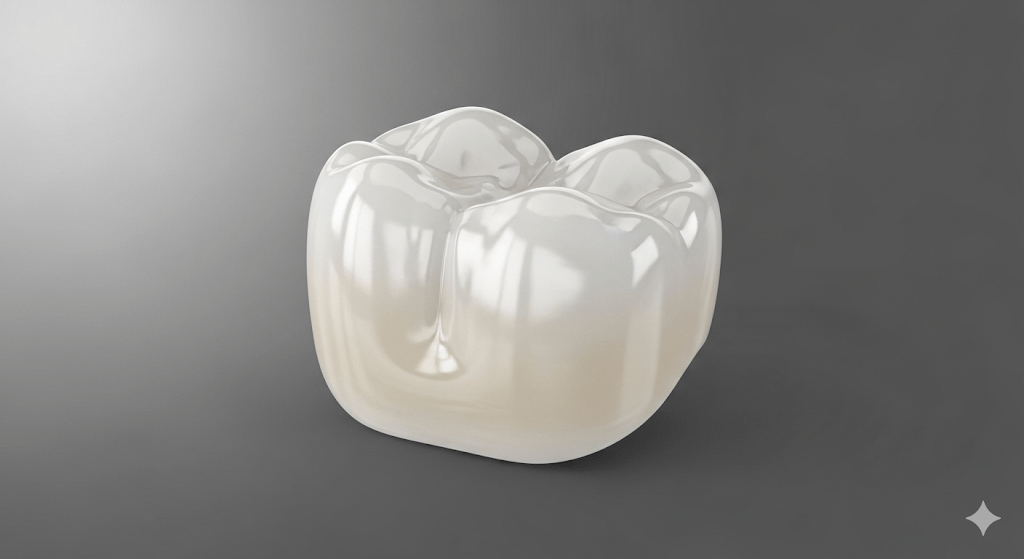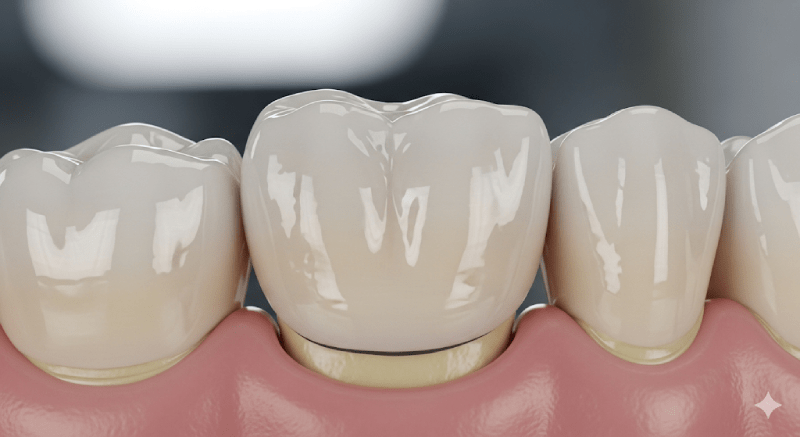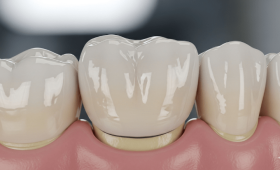What are the Differences and Similarities Between Dental Veneers and Crowns?
Dental veneers and dental crowns are two of the most frequently used treatments in aesthetic and restorative dentistry. While both aim to improve the appearance and function of teeth, there are significant differences between them. This content answers 35 questions that explain the fundamental distinctions, similarities, advantages, and disadvantages of these two treatments.
What Are Dental Veneers?
Dental veneers are very thin, custom-made porcelain or composite layers that are bonded to the front surface of a tooth. Veneers are generally used to correct the color, shape, size, and minor alignment issues of teeth. Their main purpose is aesthetic improvement. Since veneers do not cover the entire tooth, they are a less invasive method and a large part of the natural tooth structure is preserved. This allows patients to achieve a natural-looking and bright smile.
What Are Dental Crowns?
Dental crowns are prosthetic devices that resemble a “cap” that completely covers a tooth. Crowns are used to repair and protect severely damaged, weakened, cracked, or decayed teeth. Their main purpose is both aesthetic and functional restoration. Crowns provide strength and support to the tooth, restore chewing function, and prevent further damage to the tooth. They come in different types depending on the material, such as metal, porcelain, or zirconia.

What is the Difference in Scope and Use Cases?
Dental veneers are used more for cosmetic purposes because they only cover the front surface of the tooth. They are ideal if your teeth have minor cracks, stains, gaps, or slight misalignments. Dental crowns, on the other hand, are more suitable for teeth with serious structural problems because they encase the entire tooth. They are preferred for the protection and restoration of teeth that have undergone root canal treatment, have large fillings, or are severely worn down.
Is the Amount of Tooth Reduction Different?
Yes, the amount of tooth reduction is different for both treatments. For veneers, a very small amount of the tooth’s front surface (typically 0.5 mm) is shaved. This minimal intervention preserves a large part of the natural tooth structure. Crowns, however, require more extensive shaving of the entire tooth surface so that the prosthetic can fit perfectly and encase the tooth. The tooth is reduced in size so that it can be covered like a cap.
Which Treatment is More Long-Lasting?
The lifespan of both treatments depends on the material used, oral hygiene, and the patient’s habits. However, in general, dental crowns are more durable and long-lasting. While porcelain veneers can last 10-15 years, a well-cared-for crown can remain in the mouth for 15 years or more. The fact that crowns encase the entire tooth provides them with higher durability.
How Do The Costs Compare?
As a general rule, veneers are more affordable than crowns. This is because veneers require less material and the application process is shorter. However, the cost of both treatments can vary depending on the type of material used (porcelain vs. zirconia), the dentist’s experience, and the clinic’s location. Turkey offers globally affordable options for both treatments.
Which Treatment Adds Strength to Teeth?
Dental crowns add more strength and support to damaged or weakened teeth. By encasing the entire tooth, they protect it from external factors and increase its resistance to chewing forces. Veneers, on the other hand, serve more as an aesthetic layer. While composite veneers can slightly strengthen teeth, they cannot provide the same structural support as a crown.
How Does The Treatment Process Differ?
Veneer treatment is usually completed in two appointments. In the first appointment, the teeth are prepared and an impression is taken, and in the second appointment, the veneers are placed. Crown treatment may also require several appointments. However, since crowns require more preparation and a laboratory process, the total duration of the process can be a little longer. Both treatments offer a comfortable experience.
In Which Case Should Veneers Be Preferred?
Veneers should be preferred in situations where your teeth are in good overall health and you only want to address cosmetic concerns. Veneers are an excellent solution if your teeth have stains, small cracks, gaps, or slight misalignments. Your dentist will recommend veneers after confirming that your teeth are structurally sound.
In Which Case Should Crowns Be Preferred?
Crowns should be preferred in situations where your teeth are structurally weak, cracked, or severely damaged. Crowns are the right choice when a tooth that has undergone root canal treatment needs to be protected, a large filling needs to be replaced, or the chewing function of a tooth needs to be restored. Your dentist will recommend a crown when they believe a veneer is not sufficient to repair the tooth.
What Are The Similarities Between The Two Treatments?
Both treatments offer aesthetic and functional improvements, enhance the appearance of teeth, and boost patients’ self-confidence. Both veneers and crowns are custom-made to match natural teeth. Both procedures can be made from the same materials (porcelain, zirconia, etc.) and are long-lasting with proper oral care.
Which Treatment Provides a More Natural Appearance?
Today, both treatments are developed to provide a very natural appearance. However, because veneers are thinner and a part of the tooth enamel is preserved, they can reflect light more closely to a natural tooth. Zirconia and all-porcelain crowns also offer a natural aesthetic due to their translucency. The result depends on the dentist’s experience and the quality of the material used.
What Materials Are Used for Crowns and Veneers?
The most common materials used for both crowns and veneers are porcelain and zirconia. Porcelain has a natural appearance, while zirconia is stronger and more durable than porcelain. Composite resin offers a more economical alternative, especially for veneers. Your dentist will choose the most suitable material for you based on the condition of your teeth and your budget.

Do Teeth Need Special Care After Both Treatments?
Yes, after both a crown and a veneer, regular and diligent care is required. You should brush your teeth twice a day, floss, and go for regular dental check-ups. This care extends the life of the veneers and crowns and protects your oral health. Specifically, it is important to avoid biting hard foods and to take precautions against habits like teeth grinding.
Which Treatment is More Reversible?
Veneers are a more reversible procedure because less tooth structure is removed. They can be removed when necessary, and a state closer to the original structure of the tooth can be achieved. Crowns are an irreversible procedure because the entire tooth is reduced. When a crown is removed, a new crown must be placed to protect the tooth.
Does Tooth Sensitivity Occur?
Short-term sensitivity may occur after both treatments. This is caused by the interventions made during tooth preparation. However, sensitivity usually goes away on its own within a few days. If you experience persistent sensitivity, you should consult your dentist. With the right treatment and good care, the risk of sensitivity is minimized.
Which Treatment Corrects Missing Teeth?
Neither veneers nor a single crown can directly replace missing teeth. If a crown is to be used in place of a missing tooth, it is done by placing it on a dental bridge or a dental implant. In this case, the teeth on both sides of the missing tooth are supported by crowns, or an implant is placed in the spot of the missing tooth and a crown is put on top of it.
Which Treatment is Suitable for Gum Disease?
Neither treatment can be applied to patients with gum disease. Before starting the treatment, the gum disease must be completely healed. Healthy gums are a fundamental requirement for the long-term success of both veneers and crowns. Before the treatment, your dentist will check if your oral health is suitable for these procedures.
Which Treatment Provides Faster Results?
Generally, both treatments require several appointments, but veneer treatment is usually completed faster. This is because veneers require less preparation time compared to crowns. However, with today’s digital dentistry, some crown applications can also be completed in the same day.
Why is There a Price Difference Between Crowns and Veneers?
The price difference comes from the amount of material used, the complexity of the craftsmanship, and the scope of the application. Since crowns cover the entire tooth, they require more material and labor, which increases their cost. However, veneers can also have a high price due to the delicate craftsmanship and artistic skill they require.
Which Treatment is More Comfortable?
Both crown and veneer treatments are done under local anesthesia, and the patient does not feel any pain. However, post-procedure comfort may be higher with veneers because of the minimal shaving. The patient gets used to the new teeth easily within a few days.
How Should Oral Hygiene Be Maintained After Treatment?
Oral hygiene is very important after both treatments. You should brush your teeth twice a day and use floss to clean between your teeth. You may also need to use special oral care products recommended by your dentist. Regular hygiene extends the life of both crowns and veneers.
Which Treatment is Suitable for Teeth Grinding Habits?
For patients with a teeth grinding (bruxism) habit, crowns may be a more suitable option. Porcelain veneers are at risk of cracking or breaking under grinding forces. Your dentist may also recommend wearing a night guard (mouthguard) if you have this habit.
Which Treatment is Less Invasive?
Veneers are less invasive because they require less tooth reduction. A large part of the natural tooth structure is preserved. Crowns, on the other hand, require a more comprehensive intervention as they encase the entire tooth. This makes crowns an ideal solution for severely damaged teeth.
What Should Be Considered After Treatment?
Mild sensitivity and swelling are normal for the first few days after treatment. During this period, it is recommended to eat soft foods and avoid hot and cold beverages. It is also very important to follow all the instructions given by your dentist and not to miss regular check-ups.
When Are They Recommended?
Your dentist will evaluate the condition of your teeth and your expectations to recommend the most suitable treatment for you. In general, veneers are preferred for cosmetic issues, while crowns are preferred for structural problems. The right decision is made with an expert opinion.
Which Treatment is Done on an Implant?
Only crowns are applied to dental implants. Veneers need a natural tooth for support. Since the implant acts as the root of the lost tooth, a crown that completely covers it is placed on top. This restores both the function and aesthetics of the missing tooth.
Which is Better for Correcting Tooth Color?
Both veneers and crowns can correct the color of teeth. However, if your teeth are healthy and you only have color issues, veneers offer a more conservative and quick solution. Porcelain veneers are highly resistant to staining and maintain their brightness for a long time.
Why Are The Costs More Affordable In Turkey?
The cost of dental crowns and dental veneers in Turkey is lower than in many European and Western countries. The reasons for this are lower operational costs, a favorable exchange rate, and government support for medical tourism. This allows for more affordable prices without compromising on quality standards.
What is the Difference Between Composite and Porcelain Veneers?
Composite veneers are shaped directly in the mouth by the dentist, while porcelain veneers are specially prepared in a lab. Porcelain is more durable, stain-resistant, and long-lasting, but composite is more affordable and easier to repair.
What is the Difference Between Porcelain and Zirconia Crowns?
Porcelain crowns can often be metal-backed, while zirconia crowns do not contain metal. Zirconia is a stronger and lighter material than porcelain. It is highly compatible with gum tissue and offers a more natural aesthetic due to its light-transmitting properties.
Which Treatment Method is Painless?
Both methods are painless as they are performed under local anesthesia. The patient does not feel any pain or discomfort during the procedure. Any mild sensitivity that occurs after the procedure can be managed with painkillers.
Does Smoking Affect the Treatment?
Yes, smoking can shorten the lifespan of both veneers and crowns. Smoking causes the materials to stain and leads to the deterioration of gum health. This can cause decay to form under the veneers and crowns.
Which Treatment Provides Faster Results?
Veneer treatment is generally a faster process. However, the entire process varies depending on the scope of the work to be done.
Contact Cure Holiday to find the right treatment plan to beautify your smile.



